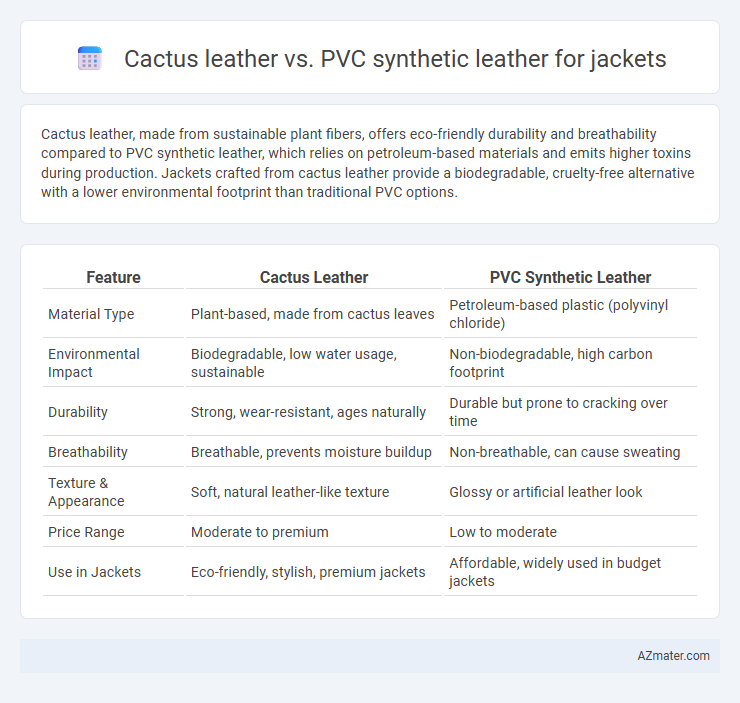Cactus leather, made from sustainable plant fibers, offers eco-friendly durability and breathability compared to PVC synthetic leather, which relies on petroleum-based materials and emits higher toxins during production. Jackets crafted from cactus leather provide a biodegradable, cruelty-free alternative with a lower environmental footprint than traditional PVC options.
Table of Comparison
| Feature | Cactus Leather | PVC Synthetic Leather |
|---|---|---|
| Material Type | Plant-based, made from cactus leaves | Petroleum-based plastic (polyvinyl chloride) |
| Environmental Impact | Biodegradable, low water usage, sustainable | Non-biodegradable, high carbon footprint |
| Durability | Strong, wear-resistant, ages naturally | Durable but prone to cracking over time |
| Breathability | Breathable, prevents moisture buildup | Non-breathable, can cause sweating |
| Texture & Appearance | Soft, natural leather-like texture | Glossy or artificial leather look |
| Price Range | Moderate to premium | Low to moderate |
| Use in Jackets | Eco-friendly, stylish, premium jackets | Affordable, widely used in budget jackets |
Introduction to Alternative Leathers
Cactus leather, derived from the mature leaves of the Nopal cactus, offers a sustainable and biodegradable alternative to traditional PVC synthetic leather, which is petroleum-based and non-biodegradable. This plant-based material provides a cruelty-free option with lower environmental impact due to its renewable raw materials and minimal water usage compared to the high energy and toxic chemical consumption in PVC production. Jackets made from cactus leather combine durability and breathable comfort, standing out as eco-friendly fashion choices while PVC synthetic leather remains popular for its affordability and water resistance but poses challenges in recyclability and long-term sustainability.
What is Cactus Leather?
Cactus leather is an innovative, sustainable material made from mature nopal cactus leaves, offering a cruelty-free and biodegradable alternative to traditional leather. It undergoes minimal chemical processing compared to PVC synthetic leather, which is derived from polyvinyl chloride, a plastic-based material with higher environmental impact due to toxic emissions and poor biodegradability. Ideal for jackets, cactus leather provides natural breathability, durability, and a unique texture while significantly reducing ecological footprint versus the non-breathable, often less durable PVC synthetic option.
Understanding PVC Synthetic Leather
PVC synthetic leather, commonly used in jacket manufacturing, is a durable material created by coating polyester fabric with polyvinyl chloride, offering water resistance and a smooth finish. Its production involves chemical processing that can release toxic compounds, contrasting with the environmentally friendly attributes of cactus leather. While PVC provides affordability and consistent quality, it lacks the biodegradability and natural texture found in plant-based alternatives like cactus leather.
Environmental Impact: Cactus vs. PVC
Cactus leather, derived from renewable plant resources, offers a biodegradable and low-water footprint alternative to PVC synthetic leather, which relies on fossil fuels and emits toxic chemicals during production and disposal. The production of cactus leather significantly reduces carbon emissions compared to PVC, contributing to a smaller environmental footprint. Unlike PVC, which releases harmful microplastics and greenhouse gases throughout its lifecycle, cactus leather supports sustainable agriculture and promotes eco-friendly fashion choices.
Durability and Longevity Comparison
Cactus leather exhibits superior durability compared to PVC synthetic leather, thanks to its natural fibrous structure that resists cracking and peeling over time. PVC synthetic leather tends to degrade faster under prolonged exposure to heat and UV light, resulting in brittleness and surface flaking. Jackets made from cactus leather often maintain their flexibility and aesthetic appeal longer, making them a more sustainable choice for long-lasting outerwear.
Comfort and Breathability Factors
Cactus leather offers superior breathability and natural moisture-wicking properties compared to PVC synthetic leather, making it more comfortable for extended wear. The plant-based material allows better air circulation and blends softness with durability, reducing heat buildup and sweat retention. PVC synthetic leather typically lacks these breathable qualities and can feel stiff or sticky, leading to discomfort during prolonged use.
Aesthetic Differences in Jacket Design
Cactus leather offers a natural, textured surface with subtle variations and an organic matte finish that enhances the sophistication of jacket designs compared to the uniform, glossy appearance of PVC synthetic leather. Jackets made from cactus leather often exhibit a more premium and eco-friendly appeal, featuring breathable and flexible material that shapes well to the body. In contrast, PVC leather jackets tend to have a shinier, plastic-like look that can appear less natural and may compromise aesthetic versatility and comfort.
Cost Analysis: Cactus Leather vs. PVC
Cactus leather typically costs significantly more than PVC synthetic leather due to its sustainable production process and natural material sourcing, with prices ranging from $50 to $100 per square meter compared to PVC's $5 to $15 per square meter. The higher initial expense of cactus leather is offset by its eco-friendly appeal and durability, making it a premium choice for high-end jackets. Conversely, PVC jackets remain popular for budget-conscious consumers due to their affordability and mass production efficiency despite environmental drawbacks.
Sustainability and Ethical Considerations
Cactus leather, derived from mature nopal cactus leaves, offers a biodegradable and renewable alternative to PVC synthetic leather, which relies on petroleum-based materials that contribute to pollution and landfill waste. The production of cactus leather requires significantly less water, pesticides, and energy, reducing environmental impact and supporting sustainable agriculture, whereas PVC manufacturing releases harmful chemicals and microplastics, raising ethical concerns. Choosing cactus leather jackets promotes cruelty-free practices and reduces carbon footprint, aligning with eco-conscious consumer values in the fashion industry.
Which Is Better for Jackets?
Cactus leather offers a sustainable and eco-friendly alternative to PVC synthetic leather, featuring natural breathability and durability ideal for jackets. PVC synthetic leather, while more affordable and highly water-resistant, often lacks the environmental benefits and long-term comfort provided by cactus leather. For those prioritizing sustainability, comfort, and natural texture, cactus leather is a better choice for jackets compared to traditional PVC options.

Infographic: Cactus leather vs PVC synthetic leather for Jacket
 azmater.com
azmater.com